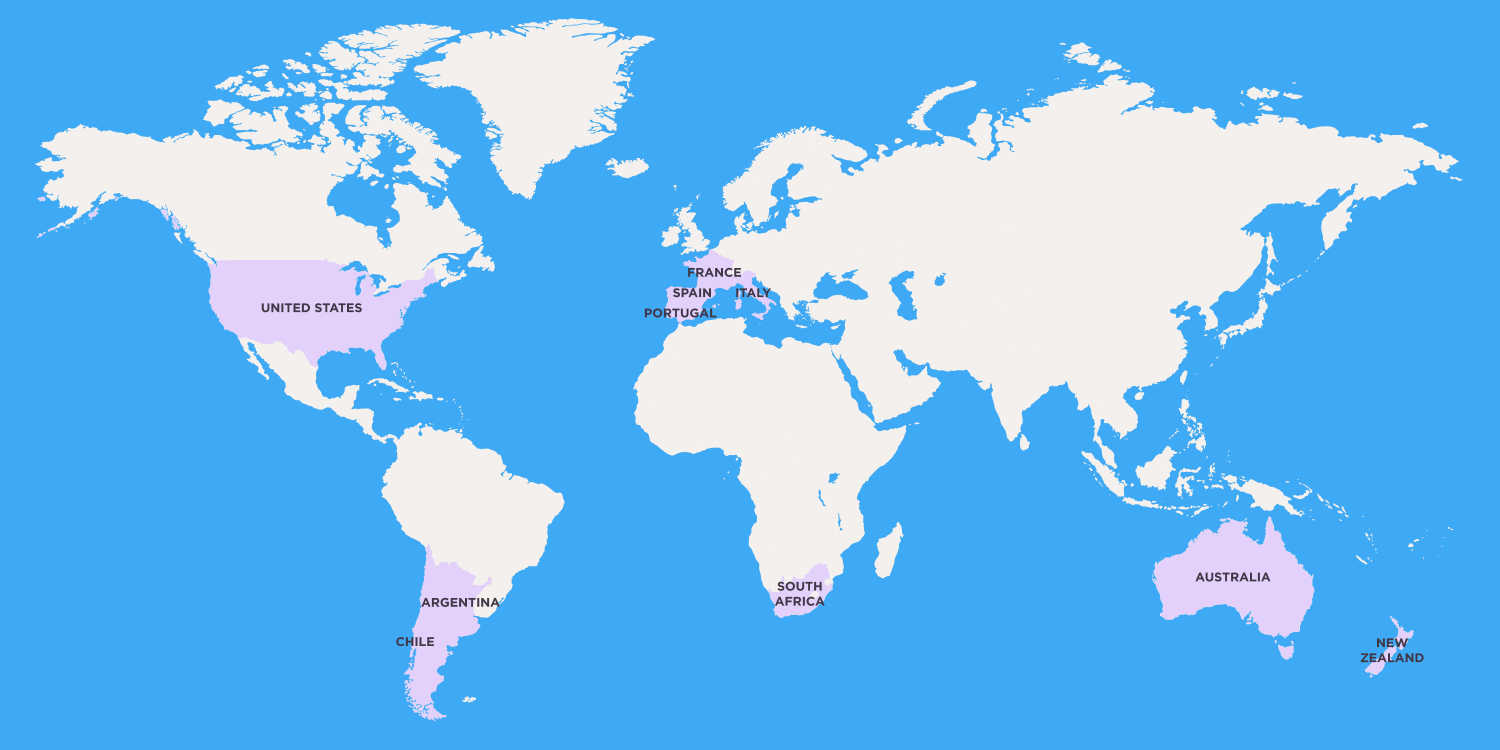Petit Verdot
Petit Verdot is best-known as one of the six grape varieties in Bordeaux's famed red blends.
Petit Verdot is best-known as one of the six grape varieties in Bordeaux's famed red blends. However, while it was an important component back in the day, its proportion in these wines has dwindled quite dramatically, and only makes up small percentages of the wines today. You can find it in Bordeaux-style blends outside France, and every now and then you will encounter a single-varietal version.
First billing in Bordeaux blends goes to Cabernet Sauvignon, Merlot and Cabernet Franc. Then there's Petit Verdot and Malbec, and even less common now, Carmenère. This French style has been emulated in various New World locales, including California, Australia, Chile, Argentina, South Africa and even Virginia, as well as other parts of Europe like Spain, Portugal and Italy's Tuscany.

Take Our Quiz Today
Get award-winning delicious wines from all over the world shipped straight to your door. Take the quiz to get the perfect pairings for your holiday season.
Take The Quiz TodayIN THIS ARTICLE:
Want personalized wines?
Get your first box of wines for $44.95 + free shipping.

History of Petit Verdot
Petit Verdot, not surprisingly, can trace back its origins to the Bordeaux region of southern France. It is thought that the grape was first planted and cultivated by the ancient Romans. It subsequently became a blending grape in Bordeaux wine.
Petit Verdot ripens very late, which eventually became a burden to winemakers in Bordeaux, who stopped using it and even uprooted portions of it starting in the 1960s and 1970s. Today, more often than not, Petit Verdot is not part of a red wine blend. When it is present, it typically makes up between 1% and 5% of the wine.
What does Petit Verdot taste like?
The defining characteristic of Petit Verdot is that it has very thick skins, resulting in high tannins and a deep color in the wines. They exhibit rich blue and black fruit, dominated by blackberry, blueberry, black currant and black cherry. The wines can also be quite spicy, display an aromatic floral and herbal character—showcased by violet, lavender and dried herbs—and sometimes meaty, gamey notes. Oak influence can add coffee and vanilla flavors.
Because of these characteristics, winemakers will add Petit Verdot to their blends to provide more structure, body, spice or color. The wines are also high in acidity and high in alcohol.
Fun Fact
Petit Verdot has a cousin called Gros Verdot, which means "big green one." Fittingly, it has larger berries.
Petit Verdot Characteristics
Petit Verdot grapes are very late-ripening, even more so than Cabernet Sauvignon. They need abundant sunshine, warmth and time on the vine to fully ripen. In cool years in Bordeaux, Petit Verdot is a wash. Also like Cabernet, it is resistant to rot, but it is also early-budding, which makes it susceptible to spring frosts. When grown properly under the right conditions, the grapes develop into small, concentrated berries with high skin-to-juice ratio, hence the tannic structure discussed earlier.
Fun Fact
The words Petit Verdot roughly translate to "little green one" in French. It was named after its proclivity toward under-ripeness.
Petit Verdot Nutritional Facts
The nutritional value of Petit Verdot varies depending on two factors: alcohol and sugar. Because Petit Verdot's alcohol levels are quite high, it is likely that these wines will contain more calories than other red wines with lower alcohol.
Alcohol in wines is dictated by how much sugar is in the grape when it's picked: More sugar means more alcohol. The more sugar there is in a wine, the more carbohydrates will be present.
How to Store and Serve Petit Verdot
Because of its pronounced tannins, Petit Verdot is actually quite ageworthy. It's recommended to cellar these reds for at least a few years to let the structure mellow and the rich flavors integrate. The best Bordeaux wines and non-French Bordeaux blends can age gracefully for years, sometimes decades. In your cellar, make sure your Petit Verdot bottles are lying on their side so the cork doesn't dry out, and that they are in a room that is cool, dry and dark.
Serving temperatures largely depend on personal preference, but it's best to go by a few basic guidelines. The recommended temperature for red wines is between 60 and 70 degrees Fahrenheit. If you don't want to fuss too much about numbers, just let the wine come to room temperature. Because of Petit Verdot's hefty structure, you might want to stick with the warmer side of the spectrum, or the tannins will be too harsh.
What to Pair with Petit Verdot
Like with all wine, you'll want to match its weight with the weight of your food. Petit Verdot is a full-bodied, rich red wine with high tannins. Red meats and other fat-rich proteins are the way to go here. Beef is a given, like a good steak or a beef stew. You could also go with pork, like barbecued ribs or pulled pork, and even braised lamb or lamb stew. If you want to keep vegetarian, try a rich, brothy pot of black beans with plenty of herbs and spices.
Petit Verdot Wine Regions Around the World
France:
Bordeaux is the most common winegrowing region in the world for Petit Verdot, where it is blended in small proportions with Cabernet Sauvignon, Merlot and Cabernet Franc, usually only in the Médoc and other parts of the Left Bank. Appellations of note include Pauillac, St.-Julien and Margaux.
United States:
Winemakers in California, particularly in Napa Valley, have mirrored Bordeaux blends for their own red wines, for which they coined the term Meritage. Petit Verdot is a component of these blends, albeit still a secondary one. This is also true in Washington state.
In Virginia, on the other hand, winemakers started making varietal Petit Verdot wines, claiming the style as their signature red. They say the grape fairs particularly well in the state's climate, so they capitalized on it and now stand out among other Petit Verdot producers for making single varietal wines.
Italy:
Winemakers in Tuscany started making so-called "super Tuscans" in the 1960s. Tired of Italy's strict DOC and DOCG regulations, a few rebels wanted to experiment with international varieties, particularly Bordeaux grapes. This is when Petit Verdot was introduced here, as part of this larger trend. You can find these wines bottled under the appellations of Toscana and Maremma Toscana.
Petit Verdot Grown Elsewhere:
Spain has some Petit Verdot plantings in the dry, warm areas of the central Castilla La Mancha.
Winemakers in Portugal's Alentejo region use Petit Verdot in some of their blends.
Australia makes mostly inexpensive versions from central regions like Murray Darling, Riverina and Riverland, as well as more serious bottlings from South Australia's Barossa.
Petit Verdot also enjoys the dry, warm climates of Chile and Argentina.
In South Africa, Petit Verdot is grown in Paarl and Stellenbosch for Bordeaux-style blends.
IN THIS ARTICLE
Want personalized wines?
Get your first box of wines for $44.95 + free shipping.


WinePrint™ by Firstleaf
Are you looking to learn more about your wine preferences? Check out our Wine Print for an in-depth look at your personal tasting profile. Discover your favorite wines, varietals, regions, and tasting notes and get personalized recommendations wherever you are.
Learn More
